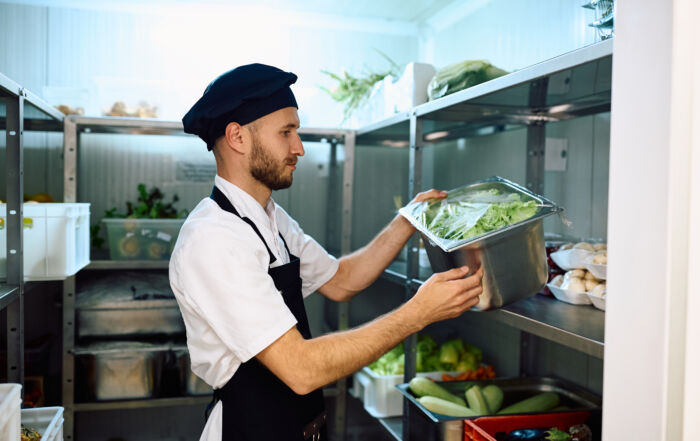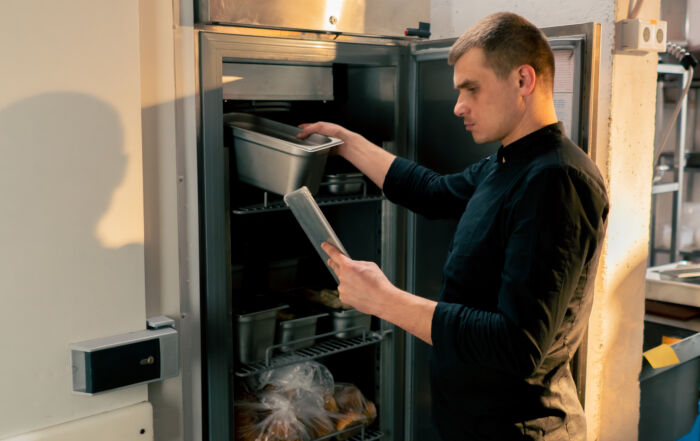Food Storage for Food Safety -And Quality!
Smart operators know that the way food is packaged and stored will affect the safety and quality of the product. Food that is poor quality frequently gets tossed, upping costs. Paying attention to storage materials and packaging is a best practice to maintain food quality. The lines between food processors and foodservice are blurring. It seems more and more foodservices are using in-house processing techniques, whether through smoking meats, use of sous vide, cook-chill, or preservation of summer produce as many farm to foodservice programs do. It is critical that proper packaging materials and processes be used.
In this blog, we will focus on considerations when communicating with vendors. Later in the month, we will address the types of food storage materials that will best maintain the safety and quality of foods.
Those in charge of purchasing food should consider the quantity needed and the packaging materials. Most of us appreciate “value buys” – I know I have on more than one occasion purchased a super-sized container of food (yes, the movie theater popcorn!) only to end up wasting some of it. Buying the “just right” amount can be tricky – that is why taking precautionary steps to ensure shelf life can prevent food loss. Food processors have their processes down pretty well. So, a foodservice might consider purchasing individually quick frozen units of meats or entrees compared to bulk packaging. The same amount can be purchased, but the individual packages gives more flexibility for use. While there may be a slightly higher unit cost, product quality and safety will be maintained.
The person who makes food buying decisions should also think about whether the packaging will protect the food from point of production to delivery at your foodservice. For some foods, proper pack and storage of the item will have a big impact on the quality when it is delivered. One example is tray packed fiberboard cases of fresh apples to protect from bruising during transit.
Food Code 2017 (and past versions) references food package materials in Chapter 3.
3-202.15 Package Integrity
Food packages shall be in good condition and protect the integrity of the contents so that the FOOD is not exposed to ADULTERATION of potential contaminants.
The Food and Drug Administration (in the Code of Federal Regulations or CFR) provide guidance to food processors about package materials to protect integrity of the food. These are food grade materials. Many food manufacturers use food grade plastics as the package container. Recognize there are different formulas for different types of plastics. Processors carefully determine the best package material to use to protect quality and safety of food. Note that plastic containers used as a food package are intended as Single Use Items, these are NOT intended for re-use as a food storage container. Food Code prohibits re-use of single use items by foodservices. Now at home, that is a different story – (Who hasn’t used cleaned margarine containers to store leftovers?). However, in foodservices, we have a responsibility for the public’s health. The issue is that the plastics break down during repeated cleaning and sanitizing. The degradation is known as “crazing”.
As the buyer, you need to be alert to the packaging used. We found in our early days with farm to school projects, local growers were using plastic garbage bags to transfer lettuce greens to the schools. They were not aware that those garbage bags are treated with chemicals to reduce odors and ward off pests. They are not intended for food contact. While most foodservice suppliers know the importance of packaging, there may be a need to communicate with local food suppliers.
Be present when food is delivered so that packages can be checked for any evidence of damage or tampering, and to verify that the package contents is reflected on the label. Also check that quality and quantity of what was ordered was delivered. These actions demonstrate that your operation has taken reasonable care to ensure safety of the food.
Risk Nothing!
READ MORE POSTS
Reducing Waste, Raising Safety: Smart Strategies for Managing Food Waste
In the face of increasing food prices and an ever-increasing demand for foodservice operations to [...]
Cooling Food in Your Operation: Best Practices
Earlier in the month, I talked a bit about safely thawing food and, in my [...]
Chilling Out: A Quick Guide to Thawing Food in Foodservice
Thawing food and cooling food are two challenges we face daily in foodservice operations. Regardless [...]
Recommitting to Food Safety in 2025, One Meal at a Time
The start of a new year is a great time to cast aside old habits and [...]










